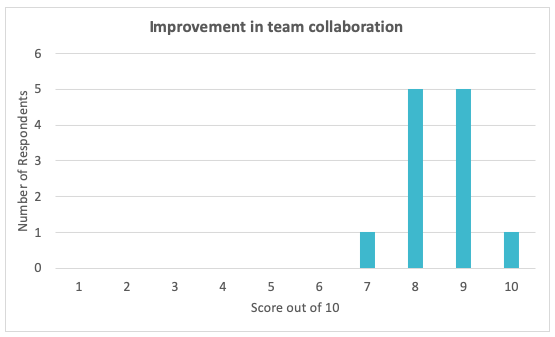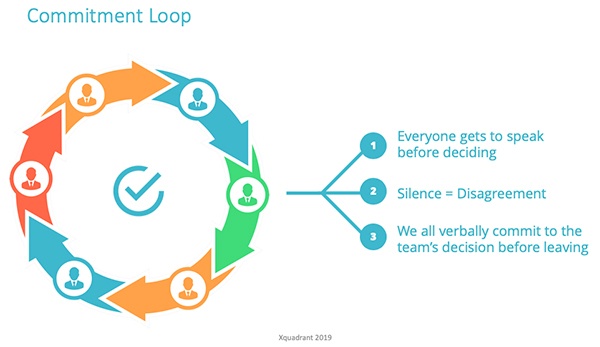Do you know this issue? You have very capable, strong performers on your leadership team, but team meetings and discussions are… unsatisfying!
It’s so frustrating because you know the calibre of people in the room and you know the team could be accomplishing so much more together.
Well, I’ve been working with a couple of really strong, high-performing leaders recently who had similar issues with their leadership team meetings.
The problems?
More...
During the course of our work together we addressed those issues. Both teams came back with extremely positive feedback - both immediately following our work but also, and more important, when I checked back in with them several months later.
Key point - the change had stuck!
Here’s one team’s rating of how well team discussions & collaboration had improved (scored out of 10).
This is not a ‘freak outlier’ : this kind of satisfaction level is the norm, and you can apply the techniques in this article to achieve a good deal of the same effect.

The leader of one team, a seasoned veteran of 25+ years international management experience, commented: “I’ve never experienced such a powerful session”.
Bolder team discussions and better team decisions
Now, how much more progress would your leadership team make on the big opportunities and challenges facing your business if you had bolder, higher-quality discussions in your team meetings?
How much more would your business grow if your leadership team made better decisions and everyone truly bought in to the action plan during your team meeting?
Well, more business growth, more enjoyment and more impact for sure.
But how do you actually move your team forward from where they are today?
Well, it turns out that there are proven and straightforward steps any leader can take to create a more conducive environment for their team to interact in a more constructive way.
In this article you’ll find what’s quite possibly the web’s most comprehensive and actionable article on this important topic. You’ll learn:
STEP I. Start with yourself (before even getting to the team meeting!)
Leaders define culture, so before we do anything else we need to look at ourselves first. Our own behaviour as a leader will make a massive difference to the quality of interaction in the team meeting, and to the overall meeting effectiveness itself.
So the first step is to identify your key ‘limiting tendency’ as a leader in how you lead team meeting discussions.
Here are 3 options for how you can do that.
OPTION 1 - Ask your team.
If you’re brave and ready to respond, send your team an email along the following lines:
Hi {THEIR NAME},
A quick question for you.
In the spirit of continuous improvement I’m looking to increase the quality of discussions, collaboration and decision-making in our management meetings. I’d love to understand what I might be inadvertently doing that might harm the quality of our interactions, so I’m polling a few trusted colleagues for input.
Can you please let me know the one thing I could do differently that would, in your view, make the biggest impact on our team meetings and discussions?
Please be honest - I will take your feedback in the constructive manner in which I know you’ll offer it.
Regards,
{YOUR NAME}
OPTION 2- Choose from the following list of common pitfalls.
Here are 6 common pitfalls that smart, ambitious leaders can fall into when working with their teams. Which one applies most to you? You can read the descriptions below, or check out this brief LinkedIn video I made on the topic.

Talking too much
The portrait:
You’re an extraverted leader; you think well on your feet and your best ideas come to you when talking things through.
But this means that you’re often one of the first to jump into a debate, and when you get going, it’s hard for other people to really get a word in edgeways! In addition to your personality, you’re the senior leader so people naturally defer to you and let you have your say.
You leave the meeting having discovered what you think about the topic, and having had your say, but you’ve been part of the “20% of people hogging 80% of the airtime” and have created passivity and disengagement in a large part of your team.
What to do about it:
Observe how much you speak in your regularly leadership team meeting. Put a reminder in your phone just before: “Watch how much I speak in this meeting” and for just after “Reflect: how much did I speak in that team meeting?”
The first reminder will help you be more intentional in the meeting, the second will help you observe what actually happened. Don’t judge yourself, just notice. Observation itself is proven to drive change better than self-criticism!

Not sharing enough
The portrait:
You’re an introverted, deep-thinking leader with high internal standards and a sense of perfectionism around your ideas.
You’re reluctant to share your thinking until it’s fully formed, meaning that you don’t table big areas for discussion until you’ve pretty much decided on a course of action.
This means that others around the table aren’t able to contribute or influence your thinking and you miss out on their different perspective on the situation.
What to do about it:
Put a regular item on the agenda entitled “Things I’m musing over”. Use this as a prompt to share your provisional thinking and questions you are considering, and invite input.

Combative attitude
The portrait:
Whether it’s because you’re a go-fast pioneering strategist or a conservative facts-orientated master of operations, you have a ‘robust’ style of debate where “you don’t suffer fools gladly” and turn the heat up on your colleagues when they disagree with your strategic insight or when they haven’t mastered the facts of the situation.
Personally, you enjoy the debate and robust exchange of views, but you fail to see to what degree it closes other people on your team off from sharing their thoughts. As a result, only the most resilient colleagues dare take you on and challenge your thinking.
What to do about it:
Understand that a ‘lively debate’ for you may well be a stressful or humiliating encounter for others on the team.

Making all the decisions
The portrait:
You’re a good decision maker. Your decisions often work out.
But you’ve a tendency to make ALL the decisions (and perhaps make them fast). If you don’t agree with something, you reject it - even if there’s consensus in the team for the alternative approach.
Your leadership team meetings don’t foster a sense of ‘all in it together’ ownership.
Instead, you’ve taken on the role of Grand Vizier - surrounded by minions and advisors - but making all the decisions. Don’t be surprised if ownership and engagement drift.
What to do about it:
Move into coaching mode: commit to asking insightful questions rather than making pronouncements. Set an intention before the meeting (e.g. set a reminder on your phone). Vow to never decide anything that is the functional responsibility of anyone on your team.
Also, observe immediately after the meeting: how many decisions came out of the meeting that you did not 100% agree with? How many decisions were made by the team, rather than by you?

Never stepping up to "make the call”
The portrait:
You’ve excellent people skills and are highly relational. You love facilitating discussions and creating a sense of harmony and agreement around decisions.
But you struggle to step up and make the call when the team can’t get too consensus, or when time doesn’t allow for a more prolonged exercise in collaborative decision-making.
Your team don’t know what you truly think or feel about the matter - and actually they’d love for you just to decide one way or the other so everyone can move forward.
What to do about it:
Accept that the organisation has given you a leadership role for a reason, and that people are expecting you to move beyond facilitation.
Be very clear up front about the process: “we need to decide on these 3 things today, and if we haven’t come to consensus by the end of the allotted period I will make the call so that we can move forward”.

Overwhelming the team with new ideas
The portrait:
You’re great at new ideas and initiatives, less good at follow-up and disciplined execution.
Every week in your team meeting you bring a new idea or strategy to the team - and they secretly roll their eyes as they wonder how they can keep you happy AND actually deliver on the rest of their workload.
Your team is hungry for focus and momentum, but you keep bringing ‘shiny new objects’ to the table. There’s a time for creating options, and there’s a time for focusing on the detailed implementation.
What to do about it:
Find someone to act as a sounding board and brainstorming partner. Thrash out your ideas and possibilities with them, but don’t bring “fresh ideas” into leadership meetings each week as it leads to a lack of focus and poor follow-through on existing actions.
Divide meetings into “execution meetings” and “strategy meetings”. Strategy meetings are where new ideas and initiatives get proposed and decided. Implementation meetings - which should be at least 80% of meetings - are when current priorities are driven forward.
OPTION 3 - Work on self-awareness.
If going to your team doesn’t feel like an option right now, and none of the portraits above resonate, then it’s time to dive deeply into understanding your own tendencies.
Some great places include personality inventory tools available (MBTI, DiSC,...). However, the key is to turn insights into in-moment awareness of how these tendencies show up in your behaviours.
One very pragmatic place to start is by reviewing the different leadership lenses as described in these articles:
Mediator | Explorer | Operator | Catalyst | Conqueror
Decide which best fits you. Then ask yourself: “what’s the dark side of my strengths, and how’s that showing up in team meetings?”
STEP II. Agree Rules of Engagement for your team meetings
Clearly, team collaboration isn’t ALL about you, the leader. Everyone needs to step up.
You may know about Google’s Project Aristotle. Google studied 180 Google teams, conducted 200-plus interviews, and analysed over 250 different team attributes to identify what made a “dream team”.
After trying and failing to find some whizz-bang algorithm, they ended up rediscovering the old but powerful idea of "group norms" - the traditions, behavioural standards, and unwritten rules that govern how teams function.
Group norms turn about to be game-changers.
In our work with leadership teams we’ve consistently found that creating ’rules of engagement’ for the team, when done right, goes a long way to improve the ability of a team to contribute, debate, hear each other’s perspective, and make balanced decisions.
The good news is you can do this for your team quickly and effectively with just a few simple steps. Check out our FREE PDF RESOURCE below:
STEP III. Implement “failsafe strategies” to adhere to those Rules of Engagement in your team meetings
Coming up with Rules of Engagement is one thing, actually using them and changing ingrained patterns of relating to each other is quite another.
Here are four easy strategies you can build into the very way you organise your meetings to make your Rules of Engagement come alive.
Strategy #1: Use the “Page Two Technique”
Context is a powerful thing: it frames a moment or event and gives it significance.
For example, saying “we have a saying” provides a powerful context for the words of wisdom that come next. Compare that with just dropping in the saying into speech without calling it out - the impact isn’t the same.
Another clear example of the power of context is in a church service. The opening words - for example “in the name of the Father, Son and Holy Spirit” - frames the event to come and focuses people’s attention on a certain way of being and relating to the ceremony at hand.
In business, we often rush from one thing to another without creating such context. The strategy of “PAGE 2” is a zero-effort way of setting context to your leadership team meetings.
Very simply, you insert something important into your regular slide deck, agenda or template. “Page 1” is going to be the name of the meeting, etc., but in Page 2 you put a reminder about the attitude, behaviours or mindsets the team has agreed to deploy during the meeting. In other words, you put the Rules of Engagement.

So the team meeting will go something like this:
(Leader brings up slide 1)
“Ok everyone, good to see you all again. Let’s get stuck in shall we?”
(Advances slide)
“Ah, yes - our rules of engagement. Almost forgot! Let’s take 30 seconds to remind ourselves of what we agreed….”
(30 second pause)
“Everyone ready? Ok, let’s address topic number one for today….”
(Advances slide, discussions begin…)
ACTION: Add your rules of engagement to “Page 2” in whatever regular template you use for your meetings.
Strategy #2: Red/Yellow/Green Cards
I made a great purchase a while back - a set of red, orange and green cards, enough for everyone on the team to have all 3 colours. This is a superb way to check in visually with the team without disrupting the momentum of a team meeting. It allows everyone to be heard. Here are a couple of good ways to use it:
Many of our clients experience this for the first time in a workshop with us, and then go on to buy their team a set of cards. I strongly recommend you do the same.
ACTION: Buy a set of red/yellow/green cards for your team

Strategy #3: The Commitment Loop
One issues most teams struggle with is to ensure everyone has been heard before making a decision and moving on. As a result, people can leave the team meeting and immediately try to change the decision, or resist the decision, or distance themselves from it.
Here’s where the Commitment loop comes into play.
The ground rules are that everyone gets a say before deciding - and that silence is taken to mean “disagreement” rather than “passive agreement”. This puts the emphasis on the team to draw out all members and solicit their views.
Remember the adage, “if people don’t weigh in they won’t buy in”.
Once a decision has been proposed, the leader goes around the table and asks each person to:
This can be also done with the green/yellow/red cards too. The key thing is that everyone actively commits to supporting the decision. If you have really strong resistance - red flag - then you’d better understand and deal with it in the meeting, rather than suffer the consequences later.

Strategy #4: Maintain Focus
Leaders define culture… so if you want the team to take the Rules of Engagement seriously, you have to lead the way. Here are three ways you can do this that will take about 90 seconds per meeting:
Conclusion: Three strategies for better team meeting discussions
In conclusion then, there are three key steps to boosting the quality of team discussions and collaboration in your leadership team meetings.
The key to this is getting a good set of Rules of Engagement. Remember to download our simple PDF guide that walks you through 3 easy options to generate good rules of engagement in your team meetings, as well as some examples that real-life clients have found to be highly effective.
Finally, if you’ve enjoyed this article we’d greatly appreciate if you could share it on LinkedIn or your other preferred social media channel.



